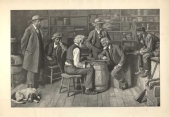The Checker Maven
The World's Most Widely Read Checkers and Draughts Publication
Bob Newell, Editor-in-Chief
Published every Saturday morning in Honolulu, Hawai`i
Noticing missing images? An explanation is here.
Our Northern Neighbor

The famed checker editor Manson D. Teetzel, whose career spanned decades of checker publishing, originally came from the town of West Lorne, in Elgin County, Ontario, Canada. No doubt "Teetzel" as he simply liked to call himself, would have been familiar with a scene similar to the one shown above, a beautiful photo of the Canadian shores of Lake Erie, not far from Mr. Teetzel's home town. (The photo is presented courtesy of photographer Rick Blaxall; more of Mr. Blaxall's work can be seen here.)
Teetzel later moved to the United States, where he published American Checker Monthly and for which he is probably best known. But while still in Ontario, he produced The Canadian Checker Player, and it's a problem from the latter journal that we present today. Teetzel didn't give an attribution for the problem; he simply set it forth, something over a century ago.
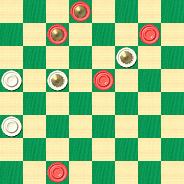
BLACK
Black to Play and Win
B:WK22,20,K19,12:BK31,K27,25,18,3.
Black is a man up, but that's about to change as White is going to even the tally on his next move. Yet Black can still win. Can you figure out how? You don't have to be Canadian to find the solution, you just have to be a Checker Player. Give it a try and then click on Read More to see the solution.![]()
Spring Into Spring When This One Springs
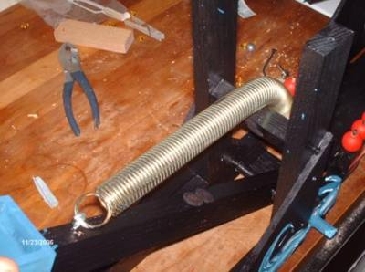
We always hear about "springing into spring" at this time of year, and the arrival of spring is always welcomed after a long winter. Shown above, though, is a spring of a different kind, and when this one springs, we think you'd better move fast and clear the area.
Moving fast and clearing the area--- on the checkerboard--- are our topics for today. We're doing something a little different; we're presenting a stroke problem as a speed problem. Unfair? How can you say such a thing! We're going to give you 60 seconds to solve this one; that's a whole minute!
When you're ready to spring into action, click on the link below--- and move fast. When you're done, spring your mouse on Read More to uncoil the solution.
April Stroke Problem (easy to moderate difficulty; 60 seconds)
![]()
Problem Composition Contests Are Back!

Old-fashioned checker problem composition contests are back, thanks to the efforts of master problemist William J. (Bill) Salot.
If you're at all familiar with checker literature, you know that solving checker problems provides an essential means of improving your game. Time and again, the experts advise us make the solution of checker problems a regular part of our study routine.
But checker problems go far beyond mere didactic purposes. A fine problem provides exquisite pleasure to the solver, and gives a view into the depth and beauty of the game of checkers.
Composing a truly great problem, a "gem" if you will, combines both art and science, with much emphasis on art. Mr. Salot is such a modern-day artist, and his goal is to start a neo-renaissance in the enjoyment and composition of checker problems.
To this end, he's started a series of problem composition contests; they've been running monthly since January 2012, with the third such contest now in progress. The prize is the designation of "unofficial world champion" problem compositor. More details and problems and solutions for both the current and previous competitions can be found here. Be sure to check this out and cast your vote for the problem you think is best.
Don't miss out. The contest problems are elegant and entertaining. Some of them are truly astounding.
Mr. Salot was very kind in granting The Checker Maven an email interview. Mr. Salot also gave us a problem composed earlier in his career, which you'll find at the end of today's column. But first, let's talk with Mr. Salot for a little while.

What gave you the idea for the problem composition contests?
I had been composing, collecting, and publishing occasional checker problems for many years. Then I fell away from the game for a few decades. When I returned to the game a few years ago, I still had the problem composing bug. But there were far fewer places to publish problems, and apparently fewer problemists too. The current contests are just a natural revival of those conducted for several years beginning in the October 1969 ACF Bulletin. Whether they will uncover many “budding” problemists remains to be seen.
How would you characterize the response so far, both from the standpoint of problemists making submissions, and audience participation?
Using the Internet has proved to be a huge advantage over the old days when everything moved by “snail” mail. The audience response in terms of the number of judges has increased from 7 in a trial contest, to 12 in Contest #1, to 35 in Contest #2. We never had more than 6 judges before the Internet. The number of competing problemists is also growing, but not that fast. We would like to have more.
How did you get interested in composing problems?
As a beginner, I did not have frequent opportunities to play across the board. My few books each had a problem section in front of the games section. I reviewed the problems first. After that, the games in contrast seemed incomplete and largely incomprehensible. As a matter of curiosity, I found myself exploring options not covered in the games. Sometimes I could make the options more interesting by doctoring the positions. That was how I got into composing.
Can you tell us about your career as a problemist?
That so-called career would have disappeared early had I not subscribed to Willie Ryan’s highly entertaining American Checkerist magazine. I sent Ryan my first problem, he said it was a hit at the NYC Club and published it, probably because a “kid” composed it. That hooked me. My “career as a problemist” has been mostly sporadic. I spent some years helping Ernie Churchill produce “Churchill’s Compilations”; and some other years collecting problems, primarily those by George H. Slocum; but mostly I have been earning a living as a professional engineer (58 years and still counting) and raising a family (3 middle-aged kids and a grandson).
What advice might you have for the budding checker problemist?
Enjoy whatever facets of the game please you most, whether it be playing or chatting with friends nearby or on the Internet; participating in crossboard tournaments for prizes or fun; collecting or researching the literature; or analyzing positions with the aim of creating either a good cook or a good problem. If you want to open the door to problem composing, forget competition, relax and treat the challenge as a true artist. Learn to appreciate the artwork of others; then take all of the time necessary to create your own. Be both your own worst critic and your own best motivator. Never give up. The product may takes weeks, even months, but the process is uplifting, not drudgery. Check every crazy move, including backwards. Utilize a computer program; it can’t compose, but it can facilitate. Each composition is a learning experience toward making the next one better. Don’t listen if someone advises you, as I was advised, to take up tennis.
What do you think makes for a good checker problem?
That is what I have been trying to find out for more than 65 years. The answer is in the eyes of the beholder. Evaluation of contest problems is seldom unanimous. You favor one style. I favor another. Composers should always favor sound, dual-free problems that feel right, without regard to the style of problem. Abhor optional sequences; try to make every move a star.
Do problems have to be difficult to be good?
No, a single move can be good. Problems with very few moves have been called gems. The most difficult problem may not win a contest. Difficulty and beauty are not synonymous.
What do you think about problems aimed at beginning and intermediate players?
Many are needed and should be assimilated by beginners and intermediate players before advancing too far. Such problems would not fare well in a contest unless the contest did not include any advanced ones.
Is there a distinction here between "teaching" problems and "artistic" problems?
They probably overlap. “Teaching” to me implies a practical objective for use in a game; e.g., standard positions. “Artistic” problems that have arisen in games have a practical “teaching” attribute. But many “artistic” problems are unlikely or cannot possibly arise in a game; they probably “teach” nothing more than appreciation of the art. The distinction is not always obvious. Some very natural-appearing settings cannot arise in a game, while some extremely unnatural settings have.
Stroke problems sometimes evoke strong likes or dislikes. What's your opinion on stroke problems?
I have composed a couple of pure strokes of which I am very proud. Probably most composers have. Big pure strokes are very difficult to create without dual solutions or optional sequences. Accomplishing such perfection deserves more recognition than it usually gets. On the other hand, deferred strokes (Slocum strokes) are seldom disliked.
What do you see for the future of your problem contests?
Past problem composing contests have seldom lasted more then a few years unless they are widely spaced. The primary cause is composer exhaustion. The way the current contests are set up, the contest frequency can be varied to accommodate the arrival frequency of new problems. I can see the current contests becoming only annual events and still surviving.
Do you think checker problem composition has a bright future in general?
I think its future is linked to the future of the game itself. Together they have a synergy that should thrive for a good while. At my age, I don’t look too far into the future.
Anything else you'd like to say to Checker Maven readers?
I would like to see some of these things discussed more widely. But more importantly, I would like to pull more talented checkerists into the problemists’ arena. I believe they would thrive.
Thank you, Mr. Salot, for taking the time to talk with us. And now, as promised, here's one of Bill's problems.
BLACK
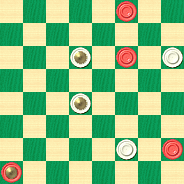
WHITE
White to Play and Win
W:B3,11,28,K29:WK10,12,K18,27.
Give it a try; it's just fine if you take your time and are a slo-poke yourself. When you're done, slo-ly poke your mouse on Read More to see the solution and Mr. Salot's problem notes.![]()
Irish Checkers
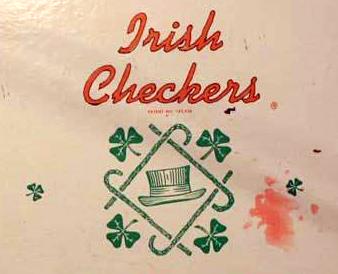
This column will appear on St. Patrick's Day, the traditional Irish holiday filled with festivities such as parades, music, green beer, corned beef and cabbage, and much song and merriment. We wish all the celebrants the top o'the day.
We don't know if Irish Checkers will be part of any of the local celebrations, and in fact we have our doubts. Irish Checkers is a proprietary game reportedly created in 1957 by Sullins Manufacturing Company, a one-man operation in Galesburg, Illinois. The game, which is neither Irish nor checkers (and if it had been Irish, it would have been called "draughts'), looked to have been a combination of Halma and Chinese Checkers (which itself is neither Chinese nor checkers) with some dice added to create a strong element of chance. Intriguing, perhaps, but the game didn't last very long, perhaps only a year or so, and Sullins Manufacturing lasted little longer.
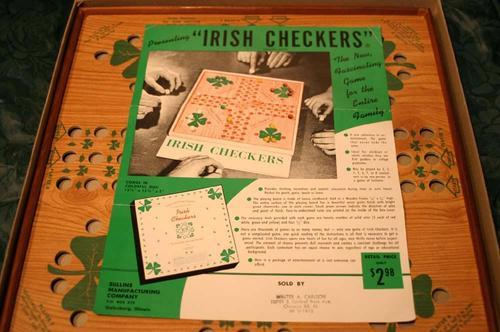
Now, we wanted to publish a problem from an historical edition of the Irish Times but we quickly found that access to the Times archives comes with a steep enough price tag to earn an instant turn-down from our corporate accountant. So instead we'll publish a problem that, while not in itself Irish, might require "the luck o'the Irish" to solve.

WHITE
White to Play and Win
W:WK2,K3,K11,K22,30:B4,K16,K20,21,K29.
Will this problem make you turn green? Will you be reduced to boiled cabbage? Or will you employ a bit of Irish wit and wisdom, and find the solution? When you've given it a good Irish try, click your mouse on Read More to see the solution.![]()
In Like a Lamb

It is traditionally said that March may "come in like a lamb and go out like a lion" or conversely "come in like a lion and go out like a lamb."
Our columns are written quite a few weeks in advance of their publication date, so we won't attempt to predict March weather in North America; that's an iffy proposition in any event.
But one thing we can do is bring March in "like a lamb" with a relatively easy top of the month stroke problem.
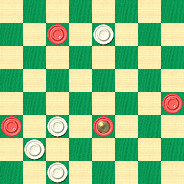
WHITE
White to Play and Win
W:W7,22,25,30:B6,20,21,K23.
So, are you a lion or a lamb? Will you roar past this problem or be meek as a lamb? We can't predict that, either, but we can say for sure that clicking your mouse on Read More will reveal the problem's solution. And here's hoping that March weather won't be too difficult, either.![]()
A February Short
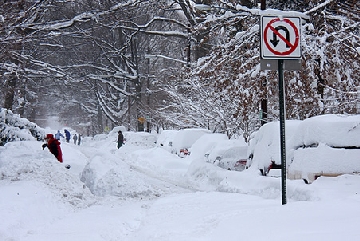
Even though this is a leap year, February remains as always the shortest month of the year. It's something to be grateful for in wintry North American climes, as this abbreviated month brings us that much closer to spring.
Today's problem is also "short" in that it is a miniature, those minimalist problems that focus our attention and often demand great accuracy and skill. Like their exact opposites, the stroke problem, they are not to everyone's taste, but unlike stroke problems, miniatures are eminently practical in nature.
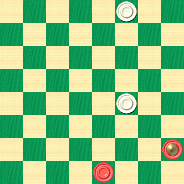
BLACK
Black to Play and Win
B:W30,14:BK5,2.
Don't give this problem short shrift; put it on your short list. After you've solved it, make a short click on Read More to see the solution.![]()
Pretty Tough

As we've noted a number of times, The Checker Maven tries to provide a variety of problems: some easy, some hard, some in-between. Today's problem, a study by celebrated problemist L. T. de Bearn, is, like the cut of meat shown above, definitely on the "tough" side. While obviously appealing to the skilled player looking for a challenge, intermediate players and even ambitious beginning players can benefit by doing some analysis and carefully playing through the solution.
So, without further ado, here's the position.
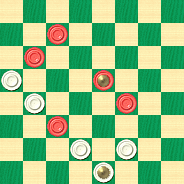
WHITE
White to Play and Draw
W:W13,17,26,27,K31:B6,9,K15,19,22.
Forces are even but White has a pretty serious mobility issue, and in checkers that can spell doom. But there is a way to a draw. Are you tough enough to find it, or will this problem chew you up? Get your teeth into this one, and then bite your mouse down on Read More to see the solution.![]()
The Speed of Winter

In continental North America, it seems that one day we're at a picnic and the next day we're buried in snow. Winter can come on fast and catch us by surprise; winter seems to have its own chilling speed.
It will be January when this column appears and no doubt there will be more than enough snow to go around in many locales. But wherever you may be, whether snowy and cold or warm and sunny (we highly recommend Hawai`i in January), you're sure to enjoy a checkers speed problem that is easier than most. Click on the link below to display the problem and start the clock. We think you can solve this one in five seconds, so that's all you're going to get! When you've got the answer, click on Read More to verify your solution.
January Speed Problem (Easy, five seconds)
![]()
New Year's Eve Spectacular

As this column is published, it's the last day of the year, New Year's Eve, and a lot of spectacular celebrations will be held throughout the world. Here in Honolulu (which due to its westerly latitude is the last major city on earth to ring in the New Year) parties abound. The photo above shows fireworks above the landmark Aloha Tower, where in 2010 a giant block party took place with seven stages, 20 DJs, and an incredible lineup of entertainment, with tickets available for as little as 15 dollars.
And believe it or not, we've found a checker problem that we think matches last year's Aloha Tower party for spectacularity--- and it won't cost you 15 dollars, or anything at all, to try it. Here's the position.

WHITE
White to Play and Draw
W:W26,20,12,6,K5:BK31,28,K21,11,3.
When originally published, the proposer stated that it might be difficult to solve without moving the pieces; yet we, like he, recommend that you try it. We'll give you a hint: it's spectacular in a certain subtle way rather than being pure fireworks, but we bet that in any event the solution will surprise you. Clicking on Read More will bring the solution to center stage.![]()
Happy Holidays

Happy holidays to one and all from The Checker Maven. We hope this holiday season will be everything you might ever wish it to be.
The holiday season here in Honolulu is bustling; it's one of the busiest times of the year for tourism, and airfares and hotel prices reflect this. If you're thinking of visiting Hawai`i some day (and we hope you are), but you'd like to do so on a budget, we definitely recommend September or October as a much more economical choice of seasons.
Whether your holidays are bustling, laid-back, or somewhere in between, we know you'll enjoy a fine checker problem to add to your festivities. You might want to settle in front of a crackling fire with a hot drink, in some climates; in others you might take the diagram to the beach with you and study it while catching some sun. However you do it, we know our selection of a Tom Wiswell problem is bound to please, even if it's more than a little on the challenging side.
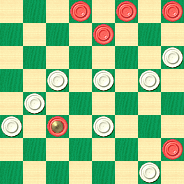
WHITE
White to Play and Win
W:W12,14,15,16,17,21,23,32:B2,3,4,7,K22,28.
So, what's the big deal, you might ask, White is two pieces ahead and should win easily. But all is not so simple. There's a big Black king in the middle of the White forces, and White is going to have to work for this one. Mr. Wiswell tells us that White will have to make no less than five "star" moves to bring home the victory.
Can you give the White forces a holiday present, or will they have to go without? Don't give up too soon; this one is well worth your time. When you've got your solution in hand, click on Read More to check your results.![]()
The Checker Maven is produced at editorial offices in Honolulu, Hawai`i, as a completely non-commercial public service from which no profit is obtained or sought. Original material is Copyright © 2004-2025 Avi Gobbler Publishing. Other material is public domain, as attributed, or licensed under Creative Commons. Information presented on this site is offered as-is, at no cost, and bears no express or implied warranty as to accuracy or usability. You agree that you use such information entirely at your own risk. No liabilities of any kind under any legal theory whatsoever are accepted. The Checker Maven is dedicated to the memory of Mr. Bob Newell, Sr.

